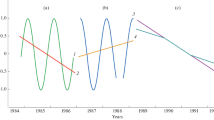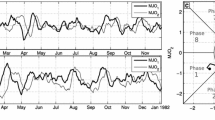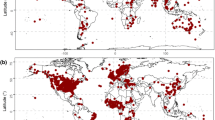Abstract
An adaptive model is proposed to describe time-varying seasonal effects. The seasonal average function is constructed using an iterative algorithm that provides a neat decomposition of the signal into a generalized trend, seasonal and residual components. By a trend, we mean long-term evolutionary changes in the average signal level, both unidirectional and chaotic, in the form of a slow random drift. This algorithm allows one to obtain unbiased estimates for each of the signal components, even in the presence of a significant number of missing observations. The series length is not required to be a multiple of an integer number of years. In contrast to the usual “Climate Normals” (CN) model, the considered adaptive model of seasonal effects assumes a continuous slow change in the properties of the seasonal component over time. The degree of allowable variability in seasonal effects from year to year is entered as a tunable parameter of the model. In particular, this allows one to show the dynamics of the growth of the amplitude of seasonal fluctuations in time in the form of a continuous (smooth) function without necessarily linking these changes to predetermined calendar epochs. The algorithm was tested on the atmospheric CO2 concentration monitoring series at Barrow, Mauna Loa, Tutuila, and South Pole stations located at different latitudes. The form of the seasonal variation was estimated, and the average amplitude of the seasonal variation and the rate of its change at each station were calculated. Noticeable differences in the dynamics of the studied parameters between stations are demonstrated. Mean amplitude of seasonal variation in CO2 concentration at Barrow, Mauna Loa, Tutuila, and South Pole stations in the epoch 2010–2019 was estimated as 18.15, 7.08, 1.30, and 1.26 ppm, respectively, and the average rate of increase in the amplitude of the seasonal variation in the increase in CO2 concentration in the interval 1976–2019 is 0.085, 0.0100, 0.0165, and 0.0031 ppm/year. In relative terms, the increase is 0.57 ± 0.03, 0.11 ± 0.02, 2.24 ± 0.24, and 0.27 ± 0.04% per year.












Similar content being viewed by others
REFERENCES
Anderson, T., The Statistical Analysis of Time Series, New York: John Wiley and Sons, 1971; Moscow: Mir, 1976.
Beckman, I.N., Khaskov, M.A., Paseka, V.I., Panarkina, L.E., and Ryazantsev, G.B., Radiation variations in the northern part of the Azov Sea, Vestn. Mosk. Univ., Ser. 2: Khim., 2003, vol. 44, no. 2, pp. 140–148.
Brendstrup, B., Hylleberg, S., Nielsen, M., Skipper, L., and Stentoft, L., Seasonality in economic models, Macroecon. Dyn., 2004, vol. 8, no. 3, pp. 362–394. https://doi.org/10.1017/S1365100504030111
Bronson, F.H., Climate change and seasonal reproduction in mammals, Philos. Trans. R. Soc. London, Ser. B., 2009, vol. 364, no. 1534, pp. 3331–3340. https://doi.org/10.1098/rstb.2009.0140
Buys Ballot, C.H.D., Les changements périodiques de température, dépendats de la nature du Soleil et de la Lune, mis en rapport avec le pronostic du temps, déduits d’observations Néerlandaises de 1729 à 1846, Utrecht: Kemink, 1847.
Carbon and Other Biogeochemical Cycles in Climate Change 2013—The Physical Science Basis: Working Group I Contribution to the Fifth Assessment Report of the Intergovernmental Panel on Climate Change, Cambridge: Cambridge Univ. Press, 2014, pp. 465–570. https://doi.org/10.1017/CBO9781107415324.015
Dagum, E.B. and Bianconcini, S., Seasonal Adjustment Methods and Real Time Trend-Cycle Estimation, Switzerland: Springer, 2016.
Das, T., Pierce, D.W., Cayan, D.R., Vano, J.A., and Lettenmaier, D.P., The importance of warm season warming to Western U.S. streamflow changes, Geophys. Res. Lett., 2011, vol. 38, no. 23. https://doi.org/10.1029/2011GL049660
Deshcherevskii, A.V., Filtration of the seasonal components of the variations in geoelectric parameters in the Garm polygon, Extended Abstract of Cand. Sci. (Phys.–Math.) Dissertation, Moscow: Inst. Dyn. Geos., Russ. Acad. Sci., 1996.
Deshcherevskii, A.V. and Lukk, A.A., Identification of regular components in time variations of geophysical parameters by the method of decomposition into nonharmonic components, Vulkanol. Seismol., 2002, no. 5, pp. 65–78.
Deshcherevskii, A.V. and Sidorin, A.Ya., Additivnaya i mul’tiplikativnaya modeli sezonnykh variatsii geofizicheskikh polei (Additive and Multiplicative Models of Seasonal Variations in the Geophysical Fields), Moscow: OIFZ RAN, 1998.
Deshcherevskii, A.V. and Sidorin, A.Ya., Nekotorye voprosy metodiki otsenki srednesezonnykh funktsii dlya geofizicheskikh dannykh (Some Problems of the Method for Estimating the Average Seasonal Functions for Geophysical Data), Moscow: OIFZ RAN, 1999.
Deshcherevskii, A.V. and Sidorin, A.Ya., Two models of seasonal variations in geophysical fields, Izv., Phys. Solid Earth, 2000, vol. 36, no. 6, pp. 449–459.
Deshcherevskii, A.V. and Sidorin, A.Ya., A two component model of geophysical processes: Seasonal variations and flicker noise, Dokl. Earth Sci., 2001, vol. 376, no. 1, pp. 65–70.
Deshcherevskii, A.V. and Sidorin, A.Ya., A flicker-noise problem in the study of cause-and-effect relationships between natural processes, Dokl. Earth Sci., 2003, vol. 392, no. 7, pp. 1030–1034.
Deshcherevskii, A.V. and Sidorin, A.Ya., Periodograms of superimposed epochs in search for hidden rhythms in experimental data time series, Seism. Instrum., 2012a, vol. 48, no. 1, pp. 57–74. https://doi.org/10.3103/S0747923912010033
Deshcherevskii, A.V. and Sidorin, A.Ya., Comparison of periodograms of superimposed epochs and Fourier spectra of experimental series, Seism. Instrum, 2012b, vol. 48, no. 3, pp. 235–255. https://doi.org/10.3103/S0747923912030048
Deshcherevskii, A.V. and Sidorin, A.Ya., Analysis of diurnal periodicity in the Dushanbe–Vakhsh catalog of earthquakes using the Rayleigh–Schuster’s hodograph method, Vopr. Inzh. Seismol., 2015, vol. 42, no. 3, pp. 71–92.
Deshcherevskii, A.V. and Sidorin, A.Ya., Iterative algorithm for time series decomposition into trend and seasonality: Testing using the example of CO2 concentrations in the atmosphere, Izv., Atmos. Ocean. Phys., 2021, vol. 57, no. 8, pp. 813–836. https://doi.org/10.1134/S0001433821080028
Deshcherevskii, A.V. and Zhuravlev, V.I., Testirovanie metodiki otsenki parametrov flikker-shuma (Testing a Technique for the Estimation of Flicker-Noise Parameters), Moscow: OIFZ RAN, 1996.
Deshcherevskii, A.V. and Zhuravlev, V.I., Analiz vremennykh ryadov s programmoi ABD (Time Series Analysis with ABD Software), Moscow: OIFZ RAN, 1997.
Deshcherevskii, A.V. and Zhuravlev, V.I., Statisticheskie svoistva i spektral’no-korrelyatsionnyi analiz aktivnosti mikrozemletryasenii na Garmskom poligone (Statistical Features and Spectral–Correlation Analysis of the Activity of Microearthquakes in the Garm Polygon), Moscow: OIFZ RAN, 2000.
Deshcherevskii, A.V., Zhuravlev, V.I., and Sidorin, A.Ya., Algorithm of seasonal variation filtering for geophysical time series, in Geofizicheskie protsessy v diskretnoi srede (Geophysical Processes in Discrete Media), Moscow: IFZ RAN, 1993, pp. 117–136.
Deshcherevskii, A.V., Zhuravlev, V.I., A. A. Lukk, and A. Ya. Sidorin, Signs of the flicker-noise structure in temporal electrometric parameters, in Izuchenie prirody variatsii geofizicheskikh polei (Study of the Nature of Geophysical Field Variations), Moscow: OIFZ RAN, 1994, pp. 5–17.
Deshcherevskii, A.V., Zhuravlev, V.I., and Sidorin, A.Ya., Spectral–temporal features of seasonal variations in apparent resistivity, Izv., Phys. Solid Earth, 1997a, vol. 33, no. 3, pp. 217–226.
Deshcherevskii, A.V., Lukk, A.A., and Sidorin, A.Ya., Flicker noise structure in the time realizations of geophysical fields, Izv., Phys. Solid Earth, 1997b, vol. 33, no. 7, pp. 515–529.
Deshcherevskii, A.V., Mukhin, V.M., and Sidorin, A.Y., Phase distinctions of seasonal variations in the soil moisture influx at stations of the Garm research area, Izv., Phys. Solid Earth, 2008, vol. 44, pp. 728–737. https://doi.org/10.1134/S1069351308090048
Deshcherevskii, A.V., Zhuravlev, V.I., Nikolsky, A.N., and Sidorin, A.Ya., ABD software: A Versatile tool for analysis of data from monitoring observations, Nauka Tekhnol. Razrab., 2016, vol. 95, no. 4, pp. 35–48. https://doi.org/10.21455/std2016.4-6
Deshcherevskii, A.V., Zhuravlev, V.I., Nikolsky, A.N., and Sidorin, A.Ya., Technologies for analyzing geophysical time series: Part 1. Software requirements, Seism. Instrum., 2017a, vol. 53, no. 1, pp. 46–59. https://doi.org/10.3103/S0747923917010030
Deshcherevskii, A.V., Zhuravlev, V.I., Nikolsky, A.N., and Sidorin, A.Ya., Technology for analyzing geophysical time series: Part 2. WinABD: A software package for maintaining and analyzing geophysical monitoring data, Seism. Instrum., 2017b, vol. 53, no. 3, pp. 203–223. https://doi.org/10.3103/S0747923917030021
Deshcherevskii, A.V., Zhuravlev, V.I., Nikolsky, A.N., and Sidorin, A.Ya., Problems of analyzing the time series with missing fragments and their solutions by using the WinABD software, Izv., Atmos. Ocean. Phys., 2017c, vol. 53, no. 7, pp. 659–678. https://doi.org/10.1134/S0001433817070027
Deshcherevskii, A.V., Zhuravlev, V.I., Nikolsky, A.N., and Sidorin, A.Ya., Analysis of rhythms in experimental signals, Izv., Atmos. Ocean. Phys., 2017d, vol. 53, no. 8, pp. 847–858. https://doi.org/10.1134/S0001433817080035
Deshcherevskii, A.V., Idarmachev, Sh.G., and Marchenko, M.N., Assessment of the seasonal variations in apparent resistance of rocks on the dam in the Chirkey HPP with shears by the level and gaps in observational series, Tr. Inst. Geol. Dag. Nauchn. Tsentra Ross. Akad. Nauk, 2019, no. 3, pp. 52–62.
Deshcherevskii, A.V., Sidorin, A.Ya., and Fattakhov, E.A., Comprehensive methodology for describing and filtering exogenic effects in monitoring data, taking into account the type of observations and experimental data defects, Seism. Instrum., 2020, vol. 56, no. 4, pp. 411–433. https://doi.org/10.3103/S0747923920040027
Economic Time Series: Modeling and Seasonality, Bell, S.H., Holan, S.H., and McElroy, T.S., CRC/Chapman and Hall, 2012.
Feng, X., Porporato, A., and Rodriguez-Iturbe, I., Changes in rainfall seasonality in the tropics, Nat. Clim. Change, 2013, vol. 3, no. 9, pp. 811–815. https://doi.org/10.1038/nclimate1907
Forestell, B., Hewitt, M., and Mondoux, S., P101: Seasonal variations in modes of presentation in ST elevation myocardial infarction, Can. J. Emerg. Med., 2020, vol. 22, no. S1, p. S101. https://doi.org/10.1017/cem.2020.307
Gavrilov, V.A., Deshcherevskii, A.V., Poltavtseva, E.V., and Sidorin, A.Ya., Technologies of preliminary data processing for multidisciplinary geophysical monitoring and a case study of their application in the Kamchatka geoacoustic observation system, Seism. Instrum., 2017, vol. 53, no. 4, pp. 296–308. https://doi.org/10.3103/S0747923917040053
Gavrilov, V.A., Panteleev, I.A., Deshcherevskii, A.V., Lander, A.V., Buss, Yu.Yu., and Vlasov, Yu.A., Stress-strain state monitoring of the geological medium, based on the multi-instrumental measurements in the boreholes: Experience of research at the Petropavlovsk-Kamchatskii geodynamic testing site (Kamchatka, Russia), Pure Appl. Geophys., 2020, vol. 177, no. 1, pp. 397–419. https://doi.org/10.1007/s00024-019-02311-3
Goswami, N., Taucher, A.A., Brix, B., Roessler, A., Koestenberger, M., Reibnegger, G., and Cvirn, G., Coagulation changes during Central Hypovolemia across seasons, J. Clin. Med., 2020, vol. 9, no. 11, p. 3461. https://doi.org/10.3390/jcm9113461
Groisman, P.Ya., Blyakharchuk, T.A., Chernokulsky, A.V., Arzhanov, M.M., Marchesini, L.B., Bogdanova, E.G., Borzenkova, I.I., Bulygina, O.N., Karpenko, A.A., Karpenko, L.V., Knight, R.W., Khon, V.Ch., Korovin, G.N., Meshcherskaya, A.V., Mokhov, I.I., et al., Climate changes in Siberia, in Regional Environmental Changes in Siberia and Their Global Consequences, Groisman, P.Ya. and Gutman, G., Eds., Dordrecht: Springer, 2013, pp. 57–109.
Gubanov, V.A., Identification of the nonstationary cyclic component from time series, Zh. Econ. Math. Metody, 2003, vol. 39, no. 1, pp. 76–89.
Gubanov, V.A., Comparison of methods for the seasonal refinement of time series, Nauchn. Tr. Inst. Narodnokhoz. Prognozirovaniya Ross. Akad. Nauk., 2010, vol. 8, pp. 149–169.
Gubanov, V.A., Extrapolation of nonstationary time series with cyclic components, in Upravlenie razvitiem krupnomasshtabnykh sistem (MLSD'2012): Tr. Shestoi mezhdunar. konf. (ezhegod. sb.) (Management of Large-Scale System Development (MLSD-2021): Proceedings of the Sixth International Conference (Annual Compendium), Vasil’ev, S.N. and Tsvirkun, A.D., Eds., 2012, pp. 184–192.
Gubanov, V.A., The spectrum and phases of conjuncture cycles of economic indicators, Anal. Model. Ekon. Sots. Process.: Mat. Komp. Obraz., 2017, vol. 24, no. 5, pp. 23–30.
Hillers, G., Ben-Zion, Y., Campillo, M., and Zigone, D., Seasonal variations of seismic velocities in the San Jacinto fault area observed with ambient seismic noise, Geophys. J. Int., 2015, vol. 202, no. 2, pp. 920–932. https://doi.org/10.1093/gji/ggv151
Idarmachev, I.Sh., Deshcherevskii, A.V., Marchenko, M.N., and Idarmachev, Sh.G., Two models of seasonal variations in apparent resistance of rocks in the dam in the offline filtration zone of the Chirkey HPP, Tr. Inst Geol. Dag. Nauchn. Tsentra Ross. Akad. Nauk, 2019, no. 4, pp. 56–61. https://doi.org/10.33580/2541-9684-2019-63-4-56-61
Konapala, G., Mishra, A.K., Wada, Y., and Mann, M.E., Climate change will affect global water availability through compounding changes in seasonal precipitation and evaporation, Nat. Commun., 2020, vol. 11, p. 3044. https://doi.org/10.1038/s41467-020-16757-w
Kreemer, C. and Zaliapin, I., Spatiotemporal correlation between seasonal variations in seismicity and horizontal dilatational strain in California, Geophys. Res. Lett., 2018, vol. 45, no. 18, pp. 9559–9568. https://doi.org/10.1029/2018GL079536
Kuzmenko, N.V., Tsyrlin, V.A., and Pliss, M.G., Seasonal dynamics of red blood parameters in healthy people in regions with different types of climate: A meta-analysis, Izv., Atmos. Ocean. Phys., 2021, vol. 57, no. 10, pp. 1271–1292. https://doi.org/10.1134/S0001433821100078
Livezey, R.E., Vinnikov, K.Y., Timofeyeva, M.M., Tinker, R., and van den Dool, H.M., Estimation and extrapolation of climate normals and climatic trends, J. Appl. Meteorol. Climatol., 2007, vol. 46, no. 11, pp. 1759–1776. https://doi.org/10.1175/2007JAMC1666.1
Magritskii, D.V. and Kenzhebaeva, A.Zh., Regularities, characteristics, and causes of the variability of annual and seasonal water runoff in the Ural river basin, Nauka. Tekh. Tekhnol. (Politekh. Vestn.), 2017, no. 3, pp. 39–61.
Majrashi, N.A., Ahearn, T.S., and Waiter, G.D., Brainstem volume mediates seasonal variation in depressive symptoms: A cross sectional study in the UK Biobank cohort, Sci. Rep., 2020, vol. 10, p. 3592. https://doi.org/10.1038/s41598-020-60620-3
Mann, M.E. and Park, J., Greenhouse warming and changes in the seasonal cycle of temperature: Models versus observations, Geophys. Res. Lett., 1996, vol. 23, no. 10, pp. 1111–1114. https://doi.org/10.1029/96GL01066
Marvel, K., Biasutti, M., Bonfils, C., Taylor, K.E., Kushnir, Y., and Cook, B.I., Observed and projected changes to the precipitation annual cycle, J. Clim., 2017, vol. 30, pp. 4983–4995. https://doi.org/10.1175/JCLI-D-16-0572.1
Metya, A., Datye, A., Chakraborty, S., Tiwari, Y.K., Sarma, D., Bora, A., and Gogoi, N., Diurnal and seasonal variability of CO2 and CH4 concentration in a semi-urban environment of Western India, Sci. Rep., 2021, vol. 11, p. 2931. https://doi.org/10.1038/s41598-021-82321-1
Pape, R., Carbon dioxide causes 80% of global warming, Acid News, December 2013, no. 4, p. 17. https://www. airclim.org/acidnews/carbon-dioxide-causes-80-global-warming.
Paromov, V.V., Zemtsov, V.A., and Kopysov, S.G., Climate in West Siberia in the phase of warming slowdown (1986–2015) and prediction of hydroclimatic resources for 2021–2030, Izv. Tomsk. Politekh. Univ., Inzh. Georesur., 2017, vol. 328, no. 1, pp. 62–74.
Pascale, S., Lucarini, V., Feng, X., Porporato, A., and Hasson, S., Projected changes of rainfall seasonality and dry spells in a high greenhouse gas emissions scenario, Clim. Dyn., 2016, vol. 46, no. 3, pp. 1331–1350. https://doi.org/10.1007/s00382-015-2648-4
Polonsky, A.B. and Shokurova, I.G., Variations of the seasonal behavior of geostrophic circulation in the Black Sea, Phys. Oceanogr., 2010, vol. 20, no. 1, pp. 14–27.
Polson, D., Hegerl, G.C., Zhang, X., and Osborn, T.J., Causes of robust seasonal land precipitation changes, J. Clim., 2013, vol. 26, pp. 6679–6697. https://doi.org/10.1175/JCLI-D-12-00474.1
Qian, C. and Zhang, X., Human influences on changes in the temperature seasonality in mid- to high-latitude land areas, J. Clim., 2015, vol. 28, pp. 5908–5921. https://doi.org/10.1175/JCLI-D-14-00821.1
Rytov, S.M., Vvedenie v statisticheskuyu radiofiziku (Introduction to Statistical Radiophysics), vol. 1: Sluchainye protsessy (Random Processes), Moscow: Nauka, Glavnaya redaktsiya fiziko-matematicheskoi literatury, 1976.
Santer, B.D., Po-Chedley, S., Zelinka, M.D., Cvijanovic, I., Bonfils, C., Fu, Q., Kiehl, J., Mears, S., Painter, J., Pallotta, G., Solomon, S., Wentz, F.J., and Zou, Ch.-Zh., Human influence on the seasonal cycle of tropospheric temperature, Science, 2018, vol. 361, no. 6399, eaas8806. https://doi.org/10.1126/science.aas8806
Shimizu, A., Iguchi, M., and Nakamichi, H., Seasonal variations of volcanic ash and aerosol emissions around Sakurajima detected by two lidars, Atmosphere, 2021, vol. 12, no. 3, id 326. https://doi.org/10.3390/atmos12030326
Sidorin, A.Ya., Variations in electric resistance of the upper layer of the Earth’s crust, Dokl. Akad. Nauk SSSR, 1984, vol. 278, no. 2, pp. 330–334.
Sidorin, A.Ya., Results of precision observations of variations in apparent resistance on the Garm polygon, Dokl. Akad. Nauk SSSR, 1986, vol. 290, no. 1, pp. 81–84.
Sidorin, A.Y., Synchronous seasonal changes in the hydrological regime and weak earthquake activity in the Garm region, Izv., Atmos. Ocean. Phys., 2012, vol. 48, pp. 724–729.
Thomson, D.J., The seasons, global temperature, and precession, Science, 1995, vol. 268, no. 5207, pp. 59–68. https://doi.org/10.1126/science.268.5207.59
Thoning, K.W., Crotwell, A.M., and Mund, J.W., Atmospheric carbon dioxide dry air mole fractions from continuous measurements at Mauna Loa, Hawaii, Barrow, Alaska, American Samoa and South Pole: 1973–2019, version 2020-08, Boulder, Colo.: NOAA GML, 2020. https://doi.org/10.15138/yaf1-bk21. ftp://aftp.cmdl.noaa. gov/data/greenhouse_gases/co2/in-situ/surface/.
Timofeeva, A.B. and Yulin, A.V., Variability of the seasonal course of ice coverage of the Laptev Sea in the 1940s, in Sovremennye problemy gidrometeorologii i monitoringa okruzhayushchei sredy na prostranstve SNG: Tez. Mezhdunar. nauch.-prakt. konf., posvyashchennoi 90-letiyu Rossiiskogo gosudarstvennogo gidrometeorologicheskogo universiteta (Current Problems of Hydrometeorology and Environmental Monitoring in the Commonwealth of Independent States: Abstracts of Presentations at the Scientific and Practical Conference Devoted to the 90th Anniversary of the State Hydrometeorological University), St. Petersburg, 2020, pp. 431–433.
Tiwari, S., Rai, R., and Agrawal, M., Annual and seasonal variations in tropospheric ozone concentrations around Varanasi, Int. J. Remote Sens., 2008, vol. 29, no. 15, pp. 4499–4514. https://doi.org/10.1080/01431160801961391
Tiwari, Yo.K., Guha, T., Valsala, V., Lopez, A.S., Cuevas, C., Fernandez, R.P., and Mahajan, A.S., Understanding atmospheric methane sub-seasonal variability over India, Atmos. Environ., 2020, vol. 223, 117206. https://doi.org/10.1016/j.atmosenv.2019.117206
Wang, J., Guan, Y., Wu, L., Guan, X., Cai, W., Huang, J., Dong, W., and Zhang, B., Changing lengths of the four seasons by global warming, Geophys. Res. Lett., 2021, vol. 48, no. 6, e2020GL091753. https://doi.org/10.1029/2020GL091753
WMO Guidelines on the Calculation of Climate Normals, Switzerland: WMO, 2017.
ACKNOWLEDGMENTS
The possibilities of using the algorithm described in this paper are illustrated by the example of long-term observations of changes in the concentration of carbon dioxide in the atmosphere, which were prepared and posted on the Internet by K.W. Thoning, A.M. Crotwell and J.W. Mund (see (Thoning et al., 2020). We are grateful to them and to all their colleagues who took part in obtaining and posting this data on the Internet, and express our interest in cooperation.
Funding
This work was carried out according to project no. 0144-2019-0011 of the State Order of the Schmidt Institute of Physics of the Earth of the Russian Academy of Sciences.
Author information
Authors and Affiliations
Corresponding authors
Ethics declarations
The authors declare that they have no conflicts of interest.
Additional information
Translated by V. Selikhanovich
Rights and permissions
About this article
Cite this article
Deshcherevskii, A.V., Sidorin, A.Y. An Algorithm for Adaptive Assessment in Time Series Seasonal Oscillations and Its Testing Based on the Example of Variations in the CO2 Concentration in the Atmosphere. Izv. Atmos. Ocean. Phys. 58, 681–707 (2022). https://doi.org/10.1134/S0001433822070027
Received:
Revised:
Accepted:
Published:
Issue Date:
DOI: https://doi.org/10.1134/S0001433822070027




